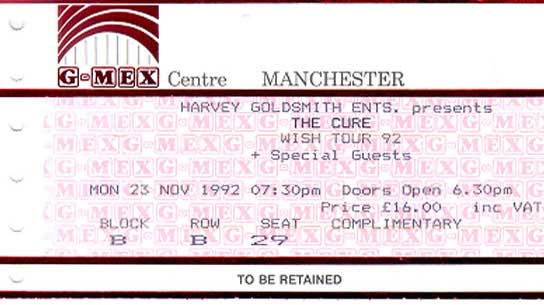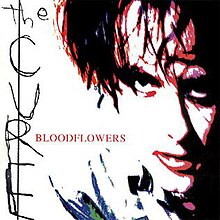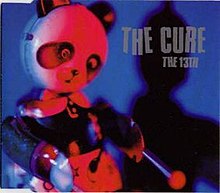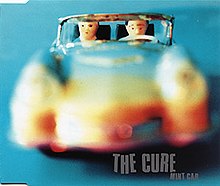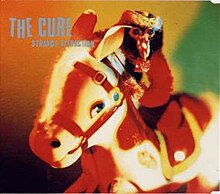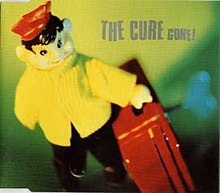
Rock and roll music
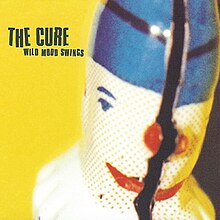
Wild Mood Swings is the tenth studio album by English rock band the Cure, released on 6 May 1996 by Fiction Records.[2] The album charted at number nine on the UK Albums Chart, staying on chart for six weeks, and charted at number 12 in the US Billboard 200.[3][4]
Four singles were released from the album, the first being "The 13th", released in 22 April 1996, followed by "Mint Car" released on 17 June, "Strange Attraction" released in United States on 8 October and "Gone!" released in Europe on 2 December 1996.
Leer másWild Mood Swings
The Cure
Discográfica: Fiction · Estudio de grabación: St Catherine`s Court (Bath, England); Haremere Hall (Etchingham, England) · Productor: Steve Lyon , Robert Smith
CHARTS
UK
AUS
AUT
FRA
GER
NL
NZ
SWE
SWI
US
SALES
CERTIFICATIONS
|
1
|
Want
The Cure •
The Cure •
w: Bamonte, Cooper, Gallup, O`Donnell and Smith •
1996 /05 /06
|
5:07 |
|
|
|
2
|
Club America
The Cure •
The Cure •
w: Bamonte, Cooper, Gallup, O`Donnell and Smith •
1996 /05 /06
|
5:01 |
|
|
|
3
|
This Is A Lie
The Cure •
The Cure •
w: Bamonte, Cooper, Gallup, O`Donnell and Smith •
1996 /05 /06
|
4:30 |
|
|
|
4
|
The 13th
The Cure •
The Cure •
w: Bamonte, Cooper, Gallup, O`Donnell and Smith •
1996 /05 /06
|
4:08 |
|
|
|
5
|
Strange Attraction
The Cure •
The Cure •
w: Bamonte, Cooper, Gallup, O`Donnell and Smith •
1996 /05 /06
|
4:19 |
|
|
|
6
|
Mint Car
The Cure •
The Cure •
w: Bamonte, Cooper, Gallup, O`Donnell and Smith •
1996 /05 /06
|
3:33 |
|
|
|
7
|
Jupiter Crash
The Cure •
The Cure •
w: Bamonte, Cooper, Gallup, O`Donnell and Smith •
1996 /05 /06
|
4:16 |
|
|
|
8
|
Round & Round & Round
The Cure •
The Cure •
w: Bamonte, Cooper, Gallup, O`Donnell and Smith •
1996 /05 /06
|
2:39 |
|
|
|
9
|
Gone!
The Cure •
The Cure •
w: Bamonte, Cooper, Gallup, O`Donnell and Smith •
1996 /05 /06
|
4:32 |
|
|
|
10
|
Numb
The Cure •
The Cure •
w: Bamonte, Cooper, Gallup, O`Donnell and Smith •
1996 /05 /06
|
4:50 |
|
|
|
11
|
Return
The Cure •
The Cure •
w: Bamonte, Cooper, Gallup, O`Donnell and Smith •
1996 /05 /06
|
3:28 |
|
|
|
12
|
Trap
The Cure •
The Cure •
w: Bamonte, Cooper, Gallup, O`Donnell and Smith •
1996 /05 /06
|
3:37 |
|
|
|
13
|
Treasure
The Cure •
The Cure •
w: Bamonte, Cooper, Gallup, O`Donnell and Smith •
1996 /05 /06
|
3:45 |
|
|
|
14
|
Bare
The Cure •
The Cure •
w: Bamonte, Cooper, Gallup, O`Donnell and Smith •
1996 /05 /06
|
7:59 |
|
Singles
The 13th
Fecha Lanzamiento: 22 Abril 1996 · Fecha Grabación: 1996 -Discográfica: Fiction · · Productor: Robert Smith , Steve Lyon
CHARTS
UK
AUS
GER
IRE
NZ
|
1
|
The 13th
The Cure •
w: swing radio mix •
1996 /04 /22 UK CD1 and Australian CD singl
|
0:00 |
|
|
|
2
|
It Used to Be Me
The Cure •
1996 /04 /22 UK CD1 and Australian CD singl
|
0:00 |
|
|
|
3
|
The 13th
The Cure •
w: Killer Bee mix •
1996 /04 /22 UK CD1 and Australian CD singl
|
0:00 |
|
|
|
4
|
The 13th
The Cure •
w: Two Chord Cool mix •
1996 /04 /22 UK CD2[9]
|
0:00 |
|
|
|
5
|
Ocean
The Cure •
1996 /04 /22 UK CD2[9]
|
0:00 |
|
|
|
6
|
Adonais
The Cure •
1996 /04 /22 UK CD2[9]
|
0:00 |
|
|
|
7
|
The 13th
The Cure •
w: swing radio mix •
1996 /04 /22 European CD and cassette singl
|
0:00 |
|
|
|
8
|
It Used to Be Me
The Cure •
1996 /04 /22 European CD and cassette singl
|
0:00 |
|
|
|
9
|
The 13th
The Cure •
w: swing radio mix •
1996 /04 /22 US CD1 and cassette single[12]
|
0:00 |
|
|
|
10
|
Adonais
The Cure •
1996 /04 /22 US CD1 and cassette single[12]
|
0:00 |
|
|
|
11
|
The 13th
The Cure •
w: Two Chord Cool mix •
1996 /04 /22 US CD2 and Canadian CD single[
|
0:00 |
|
|
|
12
|
Ocean
The Cure •
1996 /04 /22 US CD2 and Canadian CD single[
|
0:00 |
|
|
|
13
|
It Used to Be Me
The Cure •
1996 /04 /22 US CD2 and Canadian CD single[
|
0:00 |
|
|
|
14
|
The 13th
The Cure •
w: Killer Bee mix •
1996 /04 /22 US CD2 and Canadian CD single[
|
0:00 |
|
|
|
15
|
The 13th
The Cure •
w: swing radio mix •
1996 /04 /22 Japanese CD single[16]
|
0:00 |
|
|
|
16
|
It Used to Be Me
The Cure •
1996 /04 /22 Japanese CD single[16]
|
0:00 |
|
|
|
17
|
Ocean
The Cure •
1996 /04 /22 Japanese CD single[16]
|
0:00 |
|
|
|
18
|
Adonais
The Cure •
1996 /04 /22 Japanese CD single[16]
|
0:00 |
|
Mint Car
Fecha Lanzamiento: 17 Junio 1996 · Fecha Grabación: 1996 -Discográfica: FictionElektra · · Productor: Robert Smith , Steve Lyon
CHARTS
UK
AUS
|
1
|
Mint Car
The Cure •
1996 /06 /17 UK CD1[6]
|
0:00 |
|
|
|
2
|
Home
The Cure •
1996 /06 /17 UK CD1[6]
|
0:00 |
|
|
|
3
|
Mint Car
The Cure •
w: Buskers mix •
1996 /06 /17 UK CD1[6]
|
0:00 |
|
|
|
4
|
Mint Car
The Cure •
w: Electric mix •
1996 /06 /17 UK CD2[7]
|
0:00 |
|
|
|
5
|
Waiting
The Cure •
1996 /06 /17 UK CD2[7]
|
0:00 |
|
|
|
6
|
A Pink Dream
The Cure •
1996 /06 /17 UK CD2[7]
|
0:00 |
|
|
|
7
|
Mint Car
The Cure •
w: radio mix •
1996 /06 /17 European CD1 and Australian CD
|
0:00 |
|
|
|
8
|
Home
The Cure •
1996 /06 /17 European CD1 and Australian CD
|
0:00 |
|
|
|
9
|
Waiting
The Cure •
1996 /06 /17 European CD1 and Australian CD
|
0:00 |
|
|
|
10
|
A Pink Dream
The Cure •
1996 /06 /17 European CD1 and Australian CD
|
0:00 |
|
|
|
11
|
Mint Car
The Cure •
w: radio mix •
1996 /06 /17 European CD2 and US CD1[10][11
|
0:00 |
|
|
|
12
|
Home
The Cure •
1996 /06 /17 European CD2 and US CD1[10][11
|
0:00 |
|
|
|
13
|
Mint Car
The Cure •
w: Electric mix •
1996 /06 /17 US CD2 and Canadian CD single[
|
0:00 |
|
|
|
14
|
Waiting
The Cure •
1996 /06 /17 US CD2 and Canadian CD single[
|
0:00 |
|
|
|
15
|
A Pink Dream
The Cure •
1996 /06 /17 US CD2 and Canadian CD single[
|
0:00 |
|
|
|
16
|
Mint Car
The Cure •
w: Buskers Mix •
1996 /06 /17 US CD2 and Canadian CD single[
|
0:00 |
|
Strange Attraction
Fecha Lanzamiento: 8 Octubre 1996 · Fecha Grabación: 1995 -Discográfica: Elektra · · Productor: Robert Smith , Steve Lyon
CHARTS
AUS
|
1
|
Strange Attraction [Adrian Sherwood Album Mix]
The Cure •
1996 /10 /08 Side 1
|
0:00 |
|
|
|
2
|
The 13th [Feels Good Mix]
The Cure •
1996 /10 /08 Side 1
|
0:00 |
|
|
|
3
|
This is a Lie [Ambient Mix]
The Cure •
1996 /10 /08 Side 1
|
0:00 |
|
|
|
4
|
Gone! [Critter Mix]
The Cure •
1996 /10 /08 Side 1
|
0:00 |
|
|
|
5
|
Strange Attraction [Strange Mix]
The Cure •
1996 /10 /08 Side 1
|
0:00 |
|
Gone!
Fecha Lanzamiento: 2 Diciembre 1996 · Fecha Grabación: 1995 -Discográfica: Fiction · · Productor: Robert Smith , Steve Lyon
CHARTS
UK
|
1
|
Gone!
The Cure •
w: Radio Mix •
1996 /12 /02 CD 1
|
0:00 |
|
|
|
2
|
The 13th
The Cure •
w: Feels Good Mix •
1996 /12 /02 CD 1
|
0:00 |
|
|
|
3
|
This Is a Lie
The Cure •
w: Ambient Mix •
1996 /12 /02 CD 1
|
0:00 |
|
|
|
4
|
Strange Attraction
The Cure •
w: Strange Mix •
1996 /12 /02 CD 1
|
0:00 |
|
|
|
5
|
Gone!
The Cure •
w: Radio Mix •
1996 /12 /02 CD 2
|
0:00 |
|
|
|
6
|
Gone!
The Cure •
w: Critter Mix •
1996 /12 /02 CD 2
|
0:00 |
|
|
|
7
|
Gone!
The Cure •
w: Ultra Living Mix •
1996 /12 /02 CD 2
|
0:00 |
|
|
|
8
|
Gone!
The Cure •
w: Spacer Mix •
1996 /12 /02 CD 2
|
0:00 |
|
| Wild Mood Swings | ||||
|---|---|---|---|---|
 | ||||
| Studio album by | ||||
| Released | 6 May 1996 | |||
| Recorded | 1995–1996 | |||
| Studio |
| |||
| Genre | Alternative rock | |||
| Length | 61:36 | |||
| Label | Fiction | |||
| Producer |
| |||
| The Cure chronology | ||||
| ||||
| Singles from Wild Mood Swings | ||||
| ||||
Review
Wild Mood Swings is the tenth studio album by English rock band the Cure, released on 6 May 1996 by Fiction Records.[2] The album charted at number nine on the UK Albums Chart, staying on chart for six weeks, and charted at number 12 in the US Billboard 200.[3][4]
Four singles were released from the album, the first being "The 13th", released in 22 April 1996, followed by "Mint Car" released on 17 June, "Strange Attraction" released in United States on 8 October and "Gone!" released in Europe on 2 December 1996.
Leer másThe album saw the band explore various styles, similar to their double album Kiss Me Kiss Me Kiss Me (1987), incorporating jangle pop, with Mint Car[5] and Return,[6] jazz, with Gone, mariachi, with The 13th,[7]and as the title suggests the album exhibits various different moods, from lighter poppier songs to introspective, darker material, often paired next to one another, which NME described as, "essentially, rather like a compilation album, with all the disjointedness that implies.".[6]
Background
Wild Mood Swings was an album which saw various different changes towards the way the band approached recording their songs, such as the prominent use of computers and music software like Cubase, as well as live strings and brass instrumentation.[8]It was also the first album released since drummer Boris Williams left the band, due to personal reasons in 1994,[9]while guitarist Porl Thompson also left the group in 1993 to look after his children[10] and joined English rock band Page and Plant.[11]
Smith felt at the time that the previous line-up that had made Wish (1992) had "really done as much as we could. In some ways, in the back of my mind, I was slightly unsure as to what we could achieve, because we all knew each other so well. So the fact that it all kind of fell apart was a good thing. It was one of those haphazard, serendipitous things that worked in our favour."[12]
The album marked the first time the band did not work with David M. Allen as a producer since Japanese Whispers (1983). Robert Smith said of his departure, "I thought that it was time to have a change from working with Dave Allen. I was worried that nothing new was going to happen. We`ve never really needed anyone to help on the creative or artistic side, but I thought it would be best to get someone in who was younger and didn`t have any preconceptions about the group."[8]
The track "Club America", is inspired by a summer trip in 1994 that Smith had to New York in with Perry Bamonte, "I wanted to watch the football matches, the World Cup. So Depeche Mode were playing, and Perry`s brother Daryl, who now works for us, but who was working for them at the time, and I just went out with them in New York..." Smith then went clubbing with the band and admitted to playing "up to it then and awful lot more than I should have, and on the plane home, I wrote the song, because I was trying to, like, explain it away to myself. It`s ironic, you know. I`ve had this photo taken with these celebrities, and I was there, and I did that, and I was full of self loathing! And that song is not anti-the girl in the "canary feather dress," it`s actually anti-me because I was part of it."[13]
Recording
Additionally the band used live brass instruments and string quartets in their songs. something which had previously not occurred in their recording processes, featuring on tracks such as "This Is a Lie" which started out as a song based around an acoustic guitar by Perry Bamonte, Smith recalled, "when I started playing around with it, it evolved into a string piece on the keyboard. I always had in mind that we`d be using strings, right from the very outset. In that way, the house helped — there was an instant atmosphere for any string quartet walking into that room." The band chose Audrey Riley`s string quartet for the album as Smith felt she was "very aware of recording for contemporary pop" and that he had difficulties with previous musicians.[8]
The mastering of the album was complete at Metropolis Studios, London with Robert Smith alongside Ian Cooper, who was suggested to Smith by producer Flood. This made for the first time Smith would be directly involved with the mastering process, which was to due to his frustration towards being absent on the band`s previous albums` mastering.[8]
"It`s been so relaxed here. There wasn`t a deadline, so we kept pushing it back. It`s comfortable and big enough that you can get away from everybody else — so everyone`s not on top of each other."
— Roger O`Donnell discussing the album`s recording environment.
Sleeve Design and Art Direction
The album art features a toy clown, this toy motif would become a recurring theme for all of the related sleeve designs, such as the sleeve art for the singles released for the album. Bassist Simon Gallup discussed the origin to the cover and motif in a contemporary interview, "Robert had this catalogue of toys from Germany. He sent away for these different types of metal toys. They`re actually really sharp on the edges and bizarre things like these cars you wind up. The clown is really quite frightening. When we were recording , we had all these toys put over our amps and things. We thought they were such bizarre images that we tried to incorporate them into the record sleeve."[14]
Reception
| Review scores | |
|---|---|
| Source | Rating |
| AllMusic | [15] |
| Chicago Sun-Times | [16] |
| Entertainment Weekly | B[17] |
| The Guardian | [18] |
| Houston Chronicle | [19] |
| Los Angeles Times | [20] |
| NME | 7/10[21] |
| Rolling Stone | [22] |
| Spin | 6/10[23] |
| USA Today | [24] |
Wild Mood Swings received a mixed response from critics. A favourable review came from Trouser Press, which described the album as "a potent and sweeping dissertation on melancholy and tentative dreams denied," calling it "consistently compelling."[25] However, the album was the lowest-selling Cure album in 12 years, and it marked the beginning of a downward trend in the Cure`s future album sales.[26]
Smith said of the album`s poor reception, "The album suffers from being too long. And it`s disjointed. I was trying to write in different styles, and wanted us to sound like different bands, almost going after the Kiss Me idea. But, because we’d lost Boris [Williams], and before Jason [Cooper] settled in, we had a different drummer every week. I would often forget the name of the person who was drumming."... Smith felt that after Wish he "got that sense of fun back. And it shows in the album; there are some pretty demented songs on there. But it was a shame, because it got slagged when it came out. Fans hated it as well. It’s the only time I`ve been hugely disappointed." He believed that fans were unsatisfied with the lead single "The 13th" due to its "sort of crackpot salsa feel."[27]
Stephen Thomas Erlewine of AllMusic commented: "After the relatively straightforward pop of Wish, the Cure moved back toward stranger, edgier territory with Wild Mood Swings.... As the title suggests, there`s a vast array of textures and emotions on Wild Mood Swings, from the woozy mariachi lounge horns of `The 13th` to the perfect pop of `Mint Car` and the monolithic dirge of `Want.`" He praised the album`s variety saying that the band "explore some simpler territory, from contemplative acoustic numbers tinged with strings to swooning neo-psychedelia." He concluded "but the variety of sounds and strength of performance offers enough surprises to make Wild Mood Swings more than just another Cure record."[28]
Chris Gerard of Metro Weekly gave a retrospective review on the album with a mixed perspective. "There is no disputing the power of the album’s opener, though", praising the song "Want" which he believes to be one of the band`s strongest work. "Starting with a swirling guitar riff and then building slowly in intensity as it goes, “Want” is another in a long line of powerhouse opening tracks on Cure albums." He also felt that the single choices were poor and led to the album`s poor reception, stating "Particularly atrocious is “Gone!” a throwaway that was somehow deemed worthy not only to be on the album, but to be a single. “Strange Attraction” is one of the band’s weaker attempts at a pop hit, and the utterly inconsequential “Mint Car” is a pale imitation of far better guitar-based pop songs like "In Between Days" and “Friday I’m in Love.”" as well as believing that "certain B-Sides would`ve provided a much better collection of songs with the exclusion of some album tracks", and concluded that he felt the album "didn’t have to be the commercial and critical disaster that it turned out to be. The core of a great album is there — it’s just a matter of joining the right dots."[29]
Michael Gallucci of Diffuser FM gave an unenthusiastic review, saying "A tired, and often bored, mood drifts through Wild Mood Swings. It`s not even the gloom-and-doom lethargy we usually get from the band. Rather, Smith and the group can`t muster much enthusiasm for the songs", while also saying "The few times the band sparks to life are the few times it seems to latch onto a groove: `Strange Attraction`, `Mint Car`, `Gone!`."[30]
Anthony DeCurtis of Rolling Stone praised the first two tracks on the album, saying "When he’s inspired, however, Smith can still make the journey along the tracks of his tears entirely compelling “Want,” which opens the album, renders emotional desolation in gripping terms, making the most of Smith’s ability to conjure a haunting atmosphere from a simple, endlessly repeated guitar figure. On the more upbeat “Club America,” Smith borrows vocal tricks from Bowie and Iggy to evoke the jaded thrills of nightclubbing in the American fun house.", but felt that the album "recedes into generic Cure styles" and concluded "On Wild Mood Swings, Smith seems too trapped within his own obsessions to know when he’s merely expressed them and when he’s transformed them into art. It can sometimes be a thin line, but Smith has walked it before with far more satisfying results."[31]
James Hannaham of Spin observed, "Smith and the Cure remain fixated on cheap thrills throughout Wild Mood Swings. They try on degraded versions of rock genre as deftly as they put on their makeup and lipstick. We enter "Club America" to discover them ripping off the Happy Mondays` psychedelic schtick." and felt, "Smith`s three-note hooks never sounded less catchy, and the occasional arena-rock pretensions the band displays don`t exactly hit home." concluding, "Wild Mood Swings is the album you`d expect from the Cure if they`d suddenly become filthy rich, got drunk and high all the time, and had a midlife crisis."[32]
Edna Gundersen of USA Today praised the album`s sound, giving it three out of four stars, "a fun and deliberately trashy celebration of life`s pleasures. On Want, he expresses uncorked desire for "more fun, more pain, more flesh, more stars,`` and Mint Car finds him chirping happily about romance. Moods do shift wildly, from a salsa-flavored The 13th, horn-pumped Return and zippy Gone! to trademark Cure downers like Bare and Numb. The album is uneven, but highlights outweigh the low points on this bipolar flight of fancy."[33]
Track listing
All songs by Bamonte, Cooper, Gallup, O`Donnell and Smith.
| No. | Title | Length |
|---|---|---|
| 1. | "Want" | 5:06 |
| 2. | "Club America" | 5:02 |
| 3. | "This Is a Lie" | 4:29 |
| 4. | "The 13th" | 4:08 |
| 5. | "Strange Attraction" | 4:19 |
| 6. | "Mint Car" | 3:32 |
| 7. | "Jupiter Crash" | 4:15 |
| 8. | "Round & Round & Round" | 2:39 |
| 9. | "Gone!" | 4:31 |
| 10. | "Numb" | 4:49 |
| 11. | "Return" | 3:28 |
| 12. | "Trap" | 3:37 |
| 13. | "Treasure" | 3:45 |
| 14. | "Bare" | 7:57 |
Bonus track
| No. | Title | Length |
|---|---|---|
| 15. | "It Used to Be Me" (Japanese edition only - available worldwide as the B-side of "The 13th" single) | 6:50 |
Personnel
The Cure
- Robert Smith – guitar, six-string bass, vocals, production, sleeve art direction
- Perry Bamonte – guitar, six-string bass, keyboard, sleeve art direction
- Jason Cooper – percussion, drums (except on "This is a Lie", "Club America", "Mint Car", "Trap" and "Treasure"), sleeve art direction
- Simon Gallup – bass guitar, sleeve art direction
- Roger O`Donnell – keyboard, sleeve art direction
Additional personnel
- Jesus Alemany – trumpet
- John Barclay – trumpet
- Steve Dawson – trumpet
- Richard Edwards – trombone
- Sid Gauld – trumpet
- Will Gregory – saxophone
- Steve Sidwell – trumpet
- Mister Chandrashekhar – violin
- Sue Dench – viola
- Leo Payne – violin
- Audrey Riley – cello
- Chris Tombling – violin
- Ronald Austin – drums on "This is a Lie"
- Louis Pavlou – drums on "Club America"
- Mark Price – drums on "Mint Car", "Trap" and "Treasure"
- Ronald Austin – arrangements
- Sid Gauld – arrangements
- Will Gregory – arrangements
- Audrey Riley – arrangements
Technical
- Steve Lyon – production, engineering, mixing
- Paul Corkett – mixing
- Spike Drake – mixing
- Paul Q. Kolderie – mixing
- Tom Lord-Alge – mixing
- Alan Moulder – mixing
- Tim Palmer – mixing
- Mark Saunders – mixing
- Adrian Maxwell Sherwood – mixing
- Sean Slade – mixing
- Ian Cooper – mastering
- Andy Vella – sleeve art direction
Charts
Weekly charts
| Year-end charts
|
Certifications
| Region | Certification | Certified units/sales |
|---|---|---|
| United States (RIAA)[56] | Gold | 500,000^ |
^ Shipments figures based on certification alone. | ||
Wild Mood Swings is the tenth studio album by English rock band the Cure, released on 6 May 1996 by Fiction Records.[2] The album charted at number nine on the UK Albums Chart, staying on chart for six weeks, and charted at number 12 in the US Billboard 200.[3][4]
Four singles were released from the album, the first being "The 13th", released in 22 April 1996, followed by "Mint Car" released on 17 June, "Strange Attraction" released in United States on 8 October and "Gone!" released in Europe on 2 December 1996.
The album saw the band explore various styles, similar to their double album Kiss Me Kiss Me Kiss Me (1987), incorporating jangle pop, with Mint Car[5] and Return,[6] jazz, with Gone, mariachi, with The 13th,[7]and as the title suggests the album exhibits various different moods, from lighter poppier songs to introspective, darker material, often paired next to one another, which NME described as, "essentially, rather like a compilation album, with all the disjointedness that implies.".[6]
Background
Wild Mood Swings was an album which saw various different changes towards the way the band approached recording their songs, such as the prominent use of computers and music software like Cubase, as well as live strings and brass instrumentation.[8]It was also the first album released since drummer Boris Williams left the band, due to personal reasons in 1994,[9]while guitarist Porl Thompson also left the group in 1993 to look after his children[10] and joined English rock band Page and Plant.[11]
Smith felt at the time that the previous line-up that had made Wish (1992) had "really done as much as we could. In some ways, in the back of my mind, I was slightly unsure as to what we could achieve, because we all knew each other so well. So the fact that it all kind of fell apart was a good thing. It was one of those haphazard, serendipitous things that worked in our favour."[12]
The album marked the first time the band did not work with David M. Allen as a producer since Japanese Whispers (1983). Robert Smith said of his departure, "I thought that it was time to have a change from working with Dave Allen. I was worried that nothing new was going to happen. We`ve never really needed anyone to help on the creative or artistic side, but I thought it would be best to get someone in who was younger and didn`t have any preconceptions about the group."[8]
The track "Club America", is inspired by a summer trip in 1994 that Smith had to New York in with Perry Bamonte, "I wanted to watch the football matches, the World Cup. So Depeche Mode were playing, and Perry`s brother Daryl, who now works for us, but who was working for them at the time, and I just went out with them in New York..." Smith then went clubbing with the band and admitted to playing "up to it then and awful lot more than I should have, and on the plane home, I wrote the song, because I was trying to, like, explain it away to myself. It`s ironic, you know. I`ve had this photo taken with these celebrities, and I was there, and I did that, and I was full of self loathing! And that song is not anti-the girl in the "canary feather dress," it`s actually anti-me because I was part of it."[13]
Recording
Additionally the band used live brass instruments and string quartets in their songs. something which had previously not occurred in their recording processes, featuring on tracks such as "This Is a Lie" which started out as a song based around an acoustic guitar by Perry Bamonte, Smith recalled, "when I started playing around with it, it evolved into a string piece on the keyboard. I always had in mind that we`d be using strings, right from the very outset. In that way, the house helped — there was an instant atmosphere for any string quartet walking into that room." The band chose Audrey Riley`s string quartet for the album as Smith felt she was "very aware of recording for contemporary pop" and that he had difficulties with previous musicians.[8]
The mastering of the album was complete at Metropolis Studios, London with Robert Smith alongside Ian Cooper, who was suggested to Smith by producer Flood. This made for the first time Smith would be directly involved with the mastering process, which was to due to his frustration towards being absent on the band`s previous albums` mastering.[8]
"It`s been so relaxed here. There wasn`t a deadline, so we kept pushing it back. It`s comfortable and big enough that you can get away from everybody else — so everyone`s not on top of each other."
— Roger O`Donnell discussing the album`s recording environment.
Sleeve Design and Art Direction
The album art features a toy clown, this toy motif would become a recurring theme for all of the related sleeve designs, such as the sleeve art for the singles released for the album. Bassist Simon Gallup discussed the origin to the cover and motif in a contemporary interview, "Robert had this catalogue of toys from Germany. He sent away for these different types of metal toys. They`re actually really sharp on the edges and bizarre things like these cars you wind up. The clown is really quite frightening. When we were recording , we had all these toys put over our amps and things. We thought they were such bizarre images that we tried to incorporate them into the record sleeve."[14]
Reception
| Review scores | |
|---|---|
| Source | Rating |
| AllMusic | [15] |
| Chicago Sun-Times | [16] |
| Entertainment Weekly | B[17] |
| The Guardian | [18] |
| Houston Chronicle | [19] |
| Los Angeles Times | [20] |
| NME | 7/10[21] |
| Rolling Stone | [22] |
| Spin | 6/10[23] |
| USA Today | [24] |
Wild Mood Swings received a mixed response from critics. A favourable review came from Trouser Press, which described the album as "a potent and sweeping dissertation on melancholy and tentative dreams denied," calling it "consistently compelling."[25] However, the album was the lowest-selling Cure album in 12 years, and it marked the beginning of a downward trend in the Cure`s future album sales.[26]
Smith said of the album`s poor reception, "The album suffers from being too long. And it`s disjointed. I was trying to write in different styles, and wanted us to sound like different bands, almost going after the Kiss Me idea. But, because we’d lost Boris [Williams], and before Jason [Cooper] settled in, we had a different drummer every week. I would often forget the name of the person who was drumming."... Smith felt that after Wish he "got that sense of fun back. And it shows in the album; there are some pretty demented songs on there. But it was a shame, because it got slagged when it came out. Fans hated it as well. It’s the only time I`ve been hugely disappointed." He believed that fans were unsatisfied with the lead single "The 13th" due to its "sort of crackpot salsa feel."[27]
Stephen Thomas Erlewine of AllMusic commented: "After the relatively straightforward pop of Wish, the Cure moved back toward stranger, edgier territory with Wild Mood Swings.... As the title suggests, there`s a vast array of textures and emotions on Wild Mood Swings, from the woozy mariachi lounge horns of `The 13th` to the perfect pop of `Mint Car` and the monolithic dirge of `Want.`" He praised the album`s variety saying that the band "explore some simpler territory, from contemplative acoustic numbers tinged with strings to swooning neo-psychedelia." He concluded "but the variety of sounds and strength of performance offers enough surprises to make Wild Mood Swings more than just another Cure record."[28]
Chris Gerard of Metro Weekly gave a retrospective review on the album with a mixed perspective. "There is no disputing the power of the album’s opener, though", praising the song "Want" which he believes to be one of the band`s strongest work. "Starting with a swirling guitar riff and then building slowly in intensity as it goes, “Want” is another in a long line of powerhouse opening tracks on Cure albums." He also felt that the single choices were poor and led to the album`s poor reception, stating "Particularly atrocious is “Gone!” a throwaway that was somehow deemed worthy not only to be on the album, but to be a single. “Strange Attraction” is one of the band’s weaker attempts at a pop hit, and the utterly inconsequential “Mint Car” is a pale imitation of far better guitar-based pop songs like "In Between Days" and “Friday I’m in Love.”" as well as believing that "certain B-Sides would`ve provided a much better collection of songs with the exclusion of some album tracks", and concluded that he felt the album "didn’t have to be the commercial and critical disaster that it turned out to be. The core of a great album is there — it’s just a matter of joining the right dots."[29]
Michael Gallucci of Diffuser FM gave an unenthusiastic review, saying "A tired, and often bored, mood drifts through Wild Mood Swings. It`s not even the gloom-and-doom lethargy we usually get from the band. Rather, Smith and the group can`t muster much enthusiasm for the songs", while also saying "The few times the band sparks to life are the few times it seems to latch onto a groove: `Strange Attraction`, `Mint Car`, `Gone!`."[30]
Anthony DeCurtis of Rolling Stone praised the first two tracks on the album, saying "When he’s inspired, however, Smith can still make the journey along the tracks of his tears entirely compelling “Want,” which opens the album, renders emotional desolation in gripping terms, making the most of Smith’s ability to conjure a haunting atmosphere from a simple, endlessly repeated guitar figure. On the more upbeat “Club America,” Smith borrows vocal tricks from Bowie and Iggy to evoke the jaded thrills of nightclubbing in the American fun house.", but felt that the album "recedes into generic Cure styles" and concluded "On Wild Mood Swings, Smith seems too trapped within his own obsessions to know when he’s merely expressed them and when he’s transformed them into art. It can sometimes be a thin line, but Smith has walked it before with far more satisfying results."[31]
James Hannaham of Spin observed, "Smith and the Cure remain fixated on cheap thrills throughout Wild Mood Swings. They try on degraded versions of rock genre as deftly as they put on their makeup and lipstick. We enter "Club America" to discover them ripping off the Happy Mondays` psychedelic schtick." and felt, "Smith`s three-note hooks never sounded less catchy, and the occasional arena-rock pretensions the band displays don`t exactly hit home." concluding, "Wild Mood Swings is the album you`d expect from the Cure if they`d suddenly become filthy rich, got drunk and high all the time, and had a midlife crisis."[32]
Edna Gundersen of USA Today praised the album`s sound, giving it three out of four stars, "a fun and deliberately trashy celebration of life`s pleasures. On Want, he expresses uncorked desire for "more fun, more pain, more flesh, more stars,`` and Mint Car finds him chirping happily about romance. Moods do shift wildly, from a salsa-flavored The 13th, horn-pumped Return and zippy Gone! to trademark Cure downers like Bare and Numb. The album is uneven, but highlights outweigh the low points on this bipolar flight of fancy."[33]
Track listing
All songs by Bamonte, Cooper, Gallup, O`Donnell and Smith.
| No. | Title | Length |
|---|---|---|
| 1. | "Want" | 5:06 |
| 2. | "Club America" | 5:02 |
| 3. | "This Is a Lie" | 4:29 |
| 4. | "The 13th" | 4:08 |
| 5. | "Strange Attraction" | 4:19 |
| 6. | "Mint Car" | 3:32 |
| 7. | "Jupiter Crash" | 4:15 |
| 8. | "Round & Round & Round" | 2:39 |
| 9. | "Gone!" | 4:31 |
| 10. | "Numb" | 4:49 |
| 11. | "Return" | 3:28 |
| 12. | "Trap" | 3:37 |
| 13. | "Treasure" | 3:45 |
| 14. | "Bare" | 7:57 |
Bonus track
| No. | Title | Length |
|---|---|---|
| 15. | "It Used to Be Me" (Japanese edition only - available worldwide as the B-side of "The 13th" single) | 6:50 |
Personnel
The Cure
- Robert Smith – guitar, six-string bass, vocals, production, sleeve art direction
- Perry Bamonte – guitar, six-string bass, keyboard, sleeve art direction
- Jason Cooper – percussion, drums (except on "This is a Lie", "Club America", "Mint Car", "Trap" and "Treasure"), sleeve art direction
- Simon Gallup – bass guitar, sleeve art direction
- Roger O`Donnell – keyboard, sleeve art direction
Additional personnel
- Jesus Alemany – trumpet
- John Barclay – trumpet
- Steve Dawson – trumpet
- Richard Edwards – trombone
- Sid Gauld – trumpet
- Will Gregory – saxophone
- Steve Sidwell – trumpet
- Mister Chandrashekhar – violin
- Sue Dench – viola
- Leo Payne – violin
- Audrey Riley – cello
- Chris Tombling – violin
- Ronald Austin – drums on "This is a Lie"
- Louis Pavlou – drums on "Club America"
- Mark Price – drums on "Mint Car", "Trap" and "Treasure"
- Ronald Austin – arrangements
- Sid Gauld – arrangements
- Will Gregory – arrangements
- Audrey Riley – arrangements
Technical
- Steve Lyon – production, engineering, mixing
- Paul Corkett – mixing
- Spike Drake – mixing
- Paul Q. Kolderie – mixing
- Tom Lord-Alge – mixing
- Alan Moulder – mixing
- Tim Palmer – mixing
- Mark Saunders – mixing
- Adrian Maxwell Sherwood – mixing
- Sean Slade – mixing
- Ian Cooper – mastering
- Andy Vella – sleeve art direction
Charts
Weekly charts
| Year-end charts
|
Certifications
| Region | Certification | Certified units/sales |
|---|---|---|
| United States (RIAA)[56] | Gold | 500,000^ |
^ Shipments figures based on certification alone. | ||
DISCOGRAFÍA
THE CURE - WANT (40 LIVE - CURu00c6TION-25 + ANNIVERSARY) · Channel: Mercury · 5m 12s


The Cure - Club America (Original Version) · Channel: Martin Debaser · 5m 2s

The Cure - This Is A Lie · Channel: triptiger83 · 4m 30s

The Cure The 13th ( Remastered 4K with upscaling) · Channel: Remastered videos · 4m 28s
![The Cure - Strange Attraction [November 1996] The Cure - Strange Attraction [November 1996]](/images/albums/1724515585-WildMoodSwings1724515538.jpg)
The Cure - Strange Attraction [November 1996] · Channel: What s for afters? · 6m 7s

The Cure - Mint Car · Channel: TheCureVEVO · 3m 31s

The Cure - Jupiter Crash · Channel: sktttrbrain · 4m 16s

The Cure - Round Round & Round · Channel: slmountainpopcity · 2m 39s

The Cure - Gone! · Channel: TheCureVEVO · 4m 37s

THE CURE - Numb · Channel: MIXAGE100 · 4m 53s

The Cure - Return · Channel: nhadz16 · 3m 31s

The Cure - Trap (LYRICS ON SCREEN) ud83dudcfa · Channel: enc0m511 · 3m 38s

The Cure - Treasure · Channel: Musicanddeath · 3m 50s




